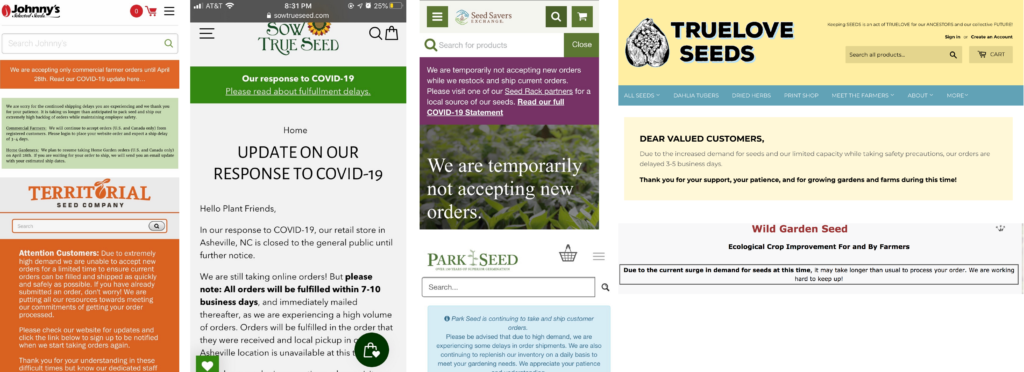by Melissa DeSa
with excerpts from Janisse Ray’s The Seed Underground: A Growing Revolution to Save Food.
Never before has such an interest in seeds and home gardening been so popular, except for during World War II when 20 million “Victory Gardens” sprung up, in a massive and coordinated effort to provide homeland food security. Sound familiar? This huge demand has put great pressure on seed companies both small and large to keep up. Many could not, with significant delays, shut downs, or limited sales only to commercial growers. Community seed libraries were shuttered and unable to distribute free seeds. Our local seed collective saw a huge surge in interest at the same time that we had to close up shop and community events.
“Seeds are the new toilet paper“, it seems.
 Just a few snapshots over the last two months of seed company websites. Fortunately most seem to be back online with minor delays.
Just a few snapshots over the last two months of seed company websites. Fortunately most seem to be back online with minor delays.
But where are these seeds coming from? Have you ever asked your farmer, who grew her seeds? Have you ever pondered that yourself when flipping through the glorious and exciting seed catalog pages making an order for yourself? My guess is no.
The story is a complex one, like everything in life there is no black or white. But the simple truth is this. Almost every farmer and gardener relies on seed companies. Without access to seeds… well, there is not much food to be grown. By and large, seed companies offer varieties with broad adaptations and market appeal that are bred for large commercial operations, rather than regional, ecological, resilient ones. Domestic seed growers have trouble making it a profitable business, the margins are razor thin. It’s a lot of work to grow seeds (trust us, we know!) and there isn’t a lot of money in. A seed company like any business, has to stay profitable or they sink. It’s resource intensive to maintain even one variety at a large scale, never mind hundreds. And coupled with a fickle market that can be unforgiving for a perishable product- it’s a tough business.
I’ve heard countless times from growers about a particular variety that they relied on for years suddenly was no longer available. Anywhere. It disappeared. Despite that crop’s importance to certain growers, if it wasn’t a big enough seller, or there was a crop failure with the seed grower, or the seed house burned down, then that variety was dropped from the catalog. We’ve heard this sad story many times, that a once favorite and staple variety (you name it: tomato, bean, radish, squash…) was gone. And no one else was saving those seeds.
Exacerbating the problem has been the consolidation of the seed industry, explosion of private over public plant breeding, patenting, GMOs, and continued loss of farmer and gardener plant breeders and seed savers. Leaving plant breeding and seed saving up to industry professionals far removed from and aware of the particular nuances of a region’s soils, people, climate and challenges – is a dangerous place to be. If we don’t have responsibility and ownership for our own seeds, our food security is at great risk.
“If you haven’t heard whats happening with seeds, let me tell you. They’re disappearing, about like every damn thing else. You know the story already, you know it better than I do, the forests and the songbirds, the Appalachian Mountains, the fish in the ocean. But I’m not going to talk about anything that’s going to make us feel hopeless or despairing, because there’s no despair in a seed. There’s only life, waiting for the right conditions- sun and water, warmth and soil-to be set free. Every day millions upon millions of seeds lift their two green wings.”
This surge in demand for seeds, these hopeful, powerful, time traveling creatures flying through the mail like never before, gives me a lot of hope. Hope that small family-run businesses that specialize in their region and support farmer-led variety improvements, are supported and seen. Hope that the full picture of a food system from seed to plate is finally being acknowledged. Hope that more seed libraries sprout from the rubble of the pandemic, and the mistreated Earth. Hope that new gardeners and experienced farmers consider seed saving as important as crop rotation, insect management, and soil fertility.
It’s imperative that we keep seeds growing and adapting in all the regional nooks and crannies around the world, because therein lies potential genetic magic for future adaptations to address climate and food security issues.
“…the world is changing and new information will be needed. But we don’t know what is in a seed; its knowledge is invisible, encased, secret. A seed can contain any number of surprises. A seed can contain a whole tree encrypted in its sealed vault. Even with climate change there will be seeds that have all the wisdom they and we need.”
Our agricultural biodiversity and our very existence, depends on it. It depends on you, me, and everyone we know that has a garden or runs a farm to save at least one thing we love. And to have a local seed company nearby that we can call up and know by name in a crisis or on any other regular day, when we just want to know what kind of seeds we should try this season. And a network of seed libraries, garden groups, and individuals that act as a decentralized, resilient community seed bank with multiple back-ups.
If you want to learn about saving seeds and be inspired, check out our free online resources and be sure to listen in to our tear-jerker and motivational live recording of our seed social with Janisse Ray and Ben Cohen. Southern Seed School can be enjoyed at your leisure anytime through our website!







